The Intel Broadwell-E Review: Core i7-6950X, i7-6900K, i7-6850K and i7-6800K Tested
by Ian Cutress on May 31, 2016 2:01 AM EST- Posted in
- CPUs
- Intel
- Enterprise
- Prosumer
- X99
- 14nm
- Broadwell-E
- HEDT
Alien: Isolation
If first person survival mixed with horror is your sort of thing, then Alien: Isolation, based off of the Alien franchise, should be an interesting title. Developed by The Creative Assembly and released in October 2014, Alien: Isolation has won numerous awards from Game Of The Year to several top 10s/25s and Best Horror titles, ratcheting up over a million sales by February 2015. Alien: Isolation uses a custom built engine which includes dynamic sound effects and should be fully multi-core enabled.
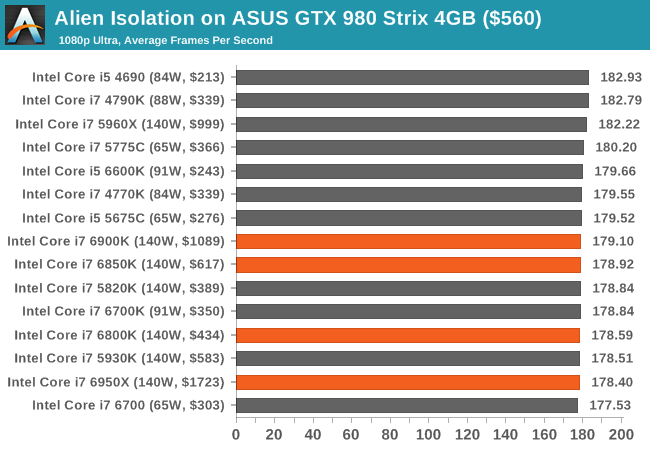
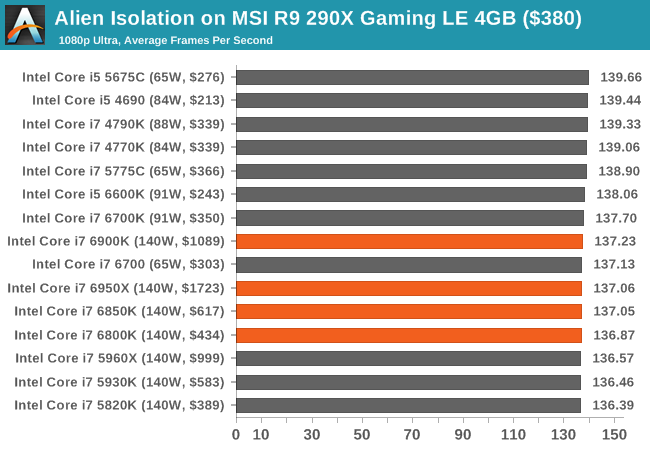
Total War: Attila
The Total War franchise moves on to Attila, another The Creative Assembly development, and is a stand-alone strategy title set in 395AD where the main story line lets the gamer take control of the leader of the Huns in order to conquer parts of the world. Graphically the game can render hundreds/thousands of units on screen at once, all with their individual actions and can put some of the big cards to task.
For low end graphics, we test at 720p with performance settings, recording the average frame rate. With mid and high range graphics, we test at 1080p with the quality setting. In both circumstances, unlimited video memory is enabled and the in-game scripted benchmark is used.
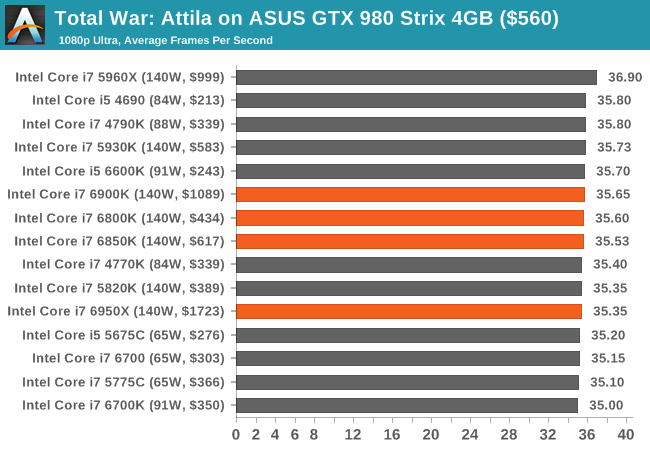
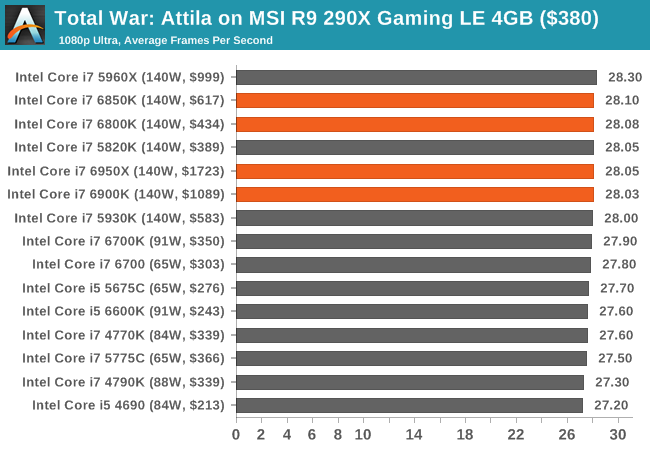
Grand Theft Auto V
The highly anticipated iteration of the Grand Theft Auto franchise finally hit the shelves on April 14th 2015, with both AMD and NVIDIA in tow to help optimize the title. GTA doesn’t provide graphical presets, but opens up the options to users and extends the boundaries by pushing even the hardest systems to the limit using Rockstar’s Advanced Game Engine. Whether the user is flying high in the mountains with long draw distances or dealing with assorted trash in the city, when cranked up to maximum it creates stunning visuals but hard work for both the CPU and the GPU.
For our test we have scripted a version of the in-game benchmark, relying only on the final part which combines a flight scene along with an in-city drive-by followed by a tanker explosion. For low end systems we test at 720p on the lowest settings, whereas mid and high-end graphics play at 1080p with very high settings across the board. We record both the average frame rate and the percentage of frames under 60 FPS (16.6ms).
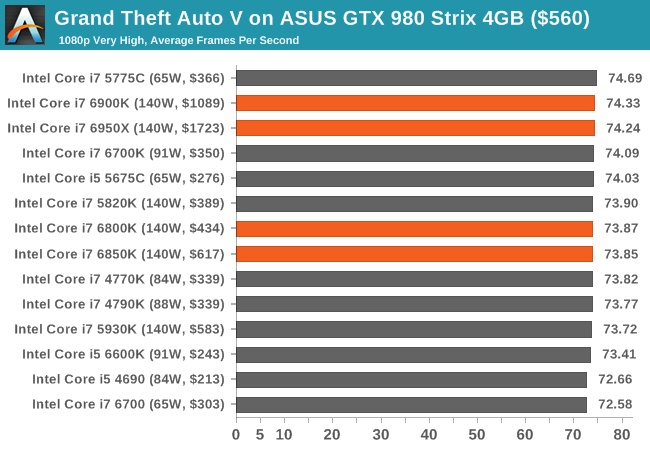














205 Comments
View All Comments
sor - Sunday, June 5, 2016 - link
Actually, without those benchmarks I wouldn't have known for sure that we were GPU limited or that CPU makes almost NO difference (I might have expected a few more FPS). I also found it interesting that one game stood out as being CPU limited.IUU - Sunday, June 5, 2016 - link
All good and awesome but Intel's persistence on maintaining many-core cpus as niche expensiveproducts is a dangerous strategy, that may ultimately lead to its downfall.
If the IT world would like to see a renewed growth, high performance computing should enter the lives of ordinary Joes. Plenty of apps could make their way into our lives via many-core cpus.
Games with really improved AI, local voice and image recognition, reading comprehension, advanced text editing, advanced 3d printing, etc etc.
Looking down on the needs of ordinary people, is nonsensical, for it is "simple joes", the needs of which led to many core cpus and advanced gpus,that the hpc world so much uses. No further development can come if the same old strategy is not applied.
Motion2082 - Monday, June 6, 2016 - link
What other XEONs would you recommend for 8 core?craveable - Tuesday, June 7, 2016 - link
Seriously, guys. My personal opinion is to skip Broadwell-E, unless you absolutely cannot wait till Q1 2017. It's a very realistic timeframe when Skylake-E will be released. Some journalist spotted a Gigabyte motherboard on Computex 2016, suited for Skylake-E, sporting a new LGA 3647 socket and 6-channel memory controller. Memory bandwidth was always a crucial selling point of HEDT CPUs, so a transition from 4 (current) to 6 (Skylake-E) is an important incremental update.craveable - Tuesday, June 7, 2016 - link
However, further studying of leaks reveled that the next HEDT will be released in Q2 2017 and be probably named Skylake-X. In the leaked roadmap the Skylake-X availability timeframe is strangely the same as for Kaby Lake-X.craveable - Wednesday, June 8, 2016 - link
However #2, it's likely, that only server part of Skylake (EP) will get LGA 3647 and 6-channel controller. And Skylake-X will get 4 channels and the same LGA 2011-3.galta - Wednesday, June 8, 2016 - link
There is no point in saying that someone should skip upgrading. But for budget constraints, if your processor is not good enough, you have to upgrade; if it still performs as you need, you do not need to upgrade, even if new generation has the same price and 50% more performance.It is said that Intel is trying to milk us with a +USD1,700 cpu and that not all softwares (games) are fully optimized for more than 2-4 cores, but if you still run a i7 9xx series, it is probably time to upgrade, even if Broadwell-E increase in performance is not huge.
mapesdhs - Thursday, June 9, 2016 - link
That makes no sense. You state that BW-E performance increase isn't that much, while saying someone with an X58 6c should still upgrade anyway. What for? Why would someone on a constrained budget spend so much for so little speed gain? Given the platform differences, X58 users would probably benefit more from newer storage tech such as M2 and newer USB3x, in which case a 5930K on a decent board would be more sensible (or a 5820K if they don't need the PCIe lanes). What you've suggested just sounds like upgrading for its own sake. These days there are far more nuanced options available, especially from the used market.fifa17 - Sunday, June 12, 2016 - link
I'm putting a system together and I'm stuck between Core i7-6850K and Core i7-6800K on a ROG STRIX X99 GAMING motherboard. The only confusing point is the number of PCI Express Lanes which is 28 for i7-6800K and 40 for the other. I've pre ordered the ASUS ROG Strix GeForce® GTX 1080 and don't plan on adding a second one in the future. I'm also not getting an optical drive of any sort and no HDDs. Just a 1TB Samsung 850 PRO SSD. Which CPU should I choose? Any ideas about these components?legolasyiu - Wednesday, June 29, 2016 - link
It will be best to get Core i7 6850 with 40 lanes for GTX 1080 16x with 850 Pro.